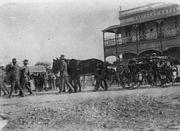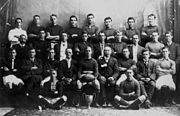- Charters Towers, Queensland
-
Charters Towers
Queensland
Aerial view of the townPopulation: 7,979(2006) Postcode: 4820 Coordinates: 20°06′S 146°16′E / 20.1°S 146.267°ECoordinates: 20°06′S 146°16′E / 20.1°S 146.267°E Elevation: 309.8 m (1,016 ft) Time zone: AEST (UTC+10) Location: - 1311 km (815 mi) from Brisbane
- 135 km (84 mi) from Townsville
LGA: Charters Towers Region State District: Dalrymple Federal Division: Kennedy Mean max temp Mean min temp Annual rainfall 30.3 °C
87 °F17.7 °C
64 °F659.5 mm
26 inCharters Towers is a city in northern Queensland, Australia. It is located 137 kilometres inland (south-west) from Townsville on the Flinders Highway. In 2006 the population was 7,979 people, some 450 fewer than in the 2001 census.[1] During the last quarter of the 19th century the town boomed as the rich gold deposits under the city were developed. After becoming uneconomic in the 20th century, profitable mining operations have commenced once again.
Contents
History and gold mining
The town was founded in the 1870s when gold was discovered by chance at Towers Hill on Christmas Eve 1871 by 12-year-old Aboriginal boy, Jupiter Mossman. Jupiter was with a small group of prospectors including Hugh Mosman, James Fraser and George Clarke. Their horses bolted after a flash of lightning. While he was searching Jupiter found both the horses and a nugget of gold in a creek at the base of Towers Hill.[2] Charters originated from the Gold Commissioner, W.S.E.M. Charters.[3] A total of ten major gold reefs were eventually mined.[2]
Such were the boom years, between 1872 and 1899, that Charters Towers hosted its own Stock Exchange. A railway between Charters Towers and the coastal port of Townsville was completed in December 1882.[3] During this period, the population was approximately 30,000, making Charters Towers Queensland's largest city outside of Brisbane.[citation needed] The city was also affectionately known as 'The World',[3] as it was said that anything one might desire could be had in the 'Towers', leaving no reason to travel elsewhere. The town was officially declared in 1877 with John McDonald being elected the town's first mayor.[3]
By 1917 gold mining became uneconomic. During World War I labour was hard to find, and as the mines drove deeper, ventilation and water problems arose. This production decline was similar across Australian gold mines, with rising costs and a fixed gold price eroding profitability. The town entered a long period of relative stagnation and little further development has occurred since.
The Charters Towers gold field produced over 200 tonnes (6.6 million troy ounces) of gold from 1871-1917.[2] The gold is concentrated into veins and was Australia's richest major field with an average grade of 34 grams per tonne. The grade was almost double that of Victorian mines and almost 75% higher than the grades of Western Australian (Kalgoorlie) gold fields of that time.[2]
Economy
Charters Towers is a regional centre for the mining industry, the beef industry and education, specifically boarding schools catering for remote rural families.
Mining
It has been estimated that there exists more gold underground than the total removed in the gold rush.[4] Hundreds of separate mining leases covering an area of 200 square kilometres were consolidated by James Lynch in the 1970s and 1980s and the company Citigold listed on the Australian Securities Exchange in 1993. After 89 years the goldfields were reopened and gold was produced again from the Warrior Mine 4 km southeast of the town in November 2006 by Citigold Corporation Limited. Gold is mined from two deposits which are accessed by sloping tunnels.[4] The extracted gold ore is trucked about 10 km south west of the city for processing into gold Doré bars. Citigold has announced plans to open three mines directly under the city to extract gold at a rate of 250,000 ounces per year.[4]
Education
Charters Towers has four secondary schools: Columba Catholic College, Blackheath and Thornburgh College, All Souls St Gabriels School and Charters Towers State High School. The nearest university is the James Cook University, in Townsville. Charters Towers is well known as a boarding school town, with families from all over western Queensland, N.T. and W.A. sending their children to school in the district because the education is very good and in not too big a town like Townsville or Cairns. The Alliance of Charters Towers State Schools represents the five State schools in the area that are funded by the Queensland Government.
Geography and climate
Charters Towers township is mildly elevated at 300 metres above sea-level, but this has a noticeable effect, with lower humidity and bigger temperature variations than nearby Townsville.[5] Charters Towers obtains its water supply from the nearby Burdekin River.
Media and communications: The Northern Miner
The Northern Miner newspaper (not to be confused with The Northern Miner, a mining publication in Canada) was first published in August 1872, just eight months after the discovery of gold.[6] Such was its strength in those gold mining days of the late 1880s that The Northern Miner installed a then revolutionary linotype slug casting machine before Brisbane's The Courier Mail. It was the only newspaper (of five published during the boom gold years) that survives today.[6] In 2000, The Northern Miner was linked for the first time to the North Queensland Newspaper Company and therefore News Limited’s electronic layout system and website.
The Goldfield Ashes
The Charters Towers Goldfield Ashes has been an amateur cricket carnival conducted over the long week-end in January since 1948 by the Charters Towers Cricket Association Incorporated (CTCA), and it is now the largest in the southern hemisphere.[7] Players ranging from regional and the country to play. Numbers in recent years have reached just shy of 200 teams. The event is of massive benefit for the town bringing in business for the entire region, especially the town's pubs and clubs. While the higher grades take it very seriously with awards and prizes given, the lower grades take to a more social view. Games involving drinking penalties and costume wearing are all part of the antics. In 2010, more teams were involved than ever. However, the competition did not reach the magic two hundred team only because of the lack of fields in the region. Many of the fields are concrete pitches on the properties of local families in the region.
Notable people
- William Edward Harney, Australian writer
- Cecil Aynsley, member of the Queensland Rugby League team of the century
- Andrew Symonds, Australian Test cricketer, spent much of his early childhood in Charters Towers
- Wilhelm Iwan (1871–1958), author, historian, and theologian (lived in Charters Towers for nine years and authored a book describing his experiences)
See also
References
- ^ Australian Bureau of Statistics (25 October 2007). "Charters Towers (Urban Centre/Locality)". 2006 Census QuickStats. http://www.censusdata.abs.gov.au/ABSNavigation/prenav/LocationSearch?collection=Census&period=2006&areacode=UCL312400&producttype=QuickStats&breadcrumb=PL&action=401. Retrieved 23 June 2011.
- ^ a b c d Charters Towers Story. Citigold Corporation. January 2010. Retrieved 24 June 2011.
- ^ a b c d "World History". Charters Towers Regional Council. http://www.charterstowers.qld.gov.au/web/guest/visitors/world_history.shtml. Retrieved 24 June 2011.
- ^ a b c "Mining Overview". Citigold Corporation. January 2010. http://www.citigold.com/Mining_Overview.asp. Retrieved 24 June 2011.
- ^ Dry Tropics.org: Evaluation of climate data for North Queensland/Brisbane
- ^ a b JCU: Historical Notes on North Queensland Newspapers - Charters Towers
- ^ goldfieldashes.com.au, 2008
External links
- University of Queensland: Queensland Places: Charters Towers
- Charters Towers City Council website
- Citigold Corporation
- Mining settlement near Charters Towers, ca. 1890 Photo held by John Oxley Library, State Library of Queensland. Photo courtesy Visitor Information Centre.
Categories:- Towns in Queensland
- North Queensland
- Charters Towers, Queensland
Wikimedia Foundation. 2010.





